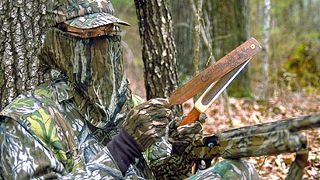|
Another obvious tough situation is when a turkey gobbles to you but goes the other way. In that case Hale says there are two likely scenarios. One is the turkey has a hen with it, and the hen doesn't want any company. "The gobbler is very interested in your calling," Hale said. "You have to always remember that any time you've got a turkey and he's answering you and you know he's answering you whether it's immediately or with a 1- or 2-second delay, then he is saying 'I recognize you as a hen.' "It has nothing to do with your calling. You don't have to get prettier, louder, or do anything to change your calling. "What you have to do is get a position to make that turkey want to give up where he is and come to you. More than likely he is following a hen. Often in the early season a hen doesn't want anything to do with company, so she's walking and leaving. "That's going to be a tough-case scenario, because every time you get in front of him, you call and she turns and leads him off again. It becomes a cat-and-mouse game that requires a lot more woodsmanship and you've got to listen more for strutting and try to head these turkeys off. That is always a very difficult situation." The same scenario late in the season can mean something different. "When a turkey gobbles and goes the other way during those times they are what I call walking gobblers or marching gobblers," Hale said. "They've got a destination in mind. He knows where 4th and Broad streets are, and it's where he always picks up his hens." Pre-hunt scouting often will help in locating strutting zones. Knowing where they are or could be can help in getting the upper hand on a turkey that acts like this. "For a turkey heading to a strut zone, you've got to get there before he does and shut up and let him come to you because he's not coming to a call," Hale said. "He's honoring you. He says, 'Man, you sound good, but nature says come to me or I'm not going to have anything to do with you. Why waste my time? I'm a breeding gobbler, I'm a dominant gobbler and I've got to fool with hens that are receptive and I know where I usually pick them up and that's where I'm heading.' "That's your strut-zone gobbler and that can be tough. So you have to do very little calling if any, and you may have to figure him out by patterning him after a two- or three-day session." Then there is the mid-morning gobbler, the one that gobbles at 10 a.m. and you hear him every once in a while, then all of the sudden he gobbles three or four times in a row. "If you're hunting in public hunting ground, the first thing that comes to mind is that somebody has that turkey fired up," Hale said. "But more than likely what has happened is he's gobbling hard because he turned around after strutting and his hen is gone. She's slipped off and gone to the nest. "The best thing to do is move in as close as you can to that turkey and give him the simplest little old yelp you can give him and he'll probably come right to you because he's panic-gobbling and he's looking for that hen. That's probably an easy turkey to kill. He's been tough all morning, but he's now become easy because the hen is not there any longer." Another common situation involves a turkey that answers you with a single gobble. The turkey isn't fired up, but it's slowly coming. "Then all of the sudden he gobbles six or seven times in a row and you wonder what's happening because you didn't do anything different," Hale said. "This can be a nightmare because he has probably seen a hen or heard a hen that you didn't see or hear and he's gobbling in response to her. More than likely he's seeing her at a distance either from one ridge to the next or 150 yards through the woods. He's excited, gobbling at her. And probably he's fixing to be done with you. That's a bad deal. "What you have to do is quickly get as aggressive as you can to get his interest back on you. And hopefully the hen will amble off in another direction. If she goes to the gobbler you're in trouble." Reading the Situation: Part III
|

